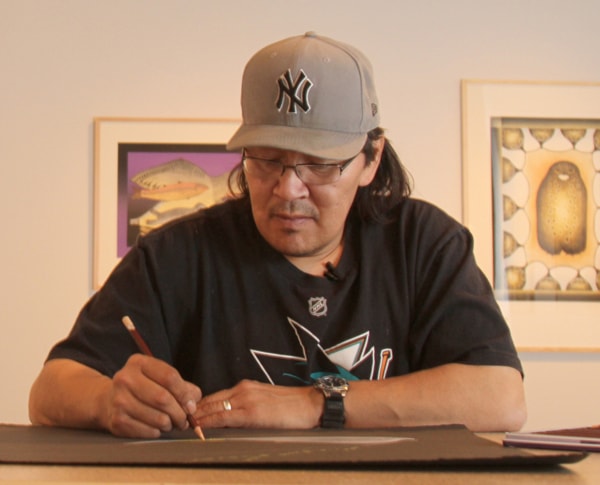Using pencil crayon and printer’s ink, Baffin Island artist Tim Pitsiulak gives southerners a colourful glimpse of life in the North, one picture at a time.
Pitsiulak, who is a visiting artist at the Red Deer Museum and Art Gallery until March 3, has two slice-of-life artworks hanging in the museum’s exhibit Uuturautiit — Cape Dorset Celebrates 50 years of Printmaking.
An Inuit carver is depicted hauling groceries in plastic Home Hardware sacks in Carver’s Income, his pencil crayon and ink drawing from 2009.
“We don’t have the store, just the bags,” said Pitsiulak, explaining the local co-op grocery store packs food items in lots of different bags — many from retailers that have yet to make a northern presence.
His large, colourful 2008 lithograph Family of Eight shows a mother, baby, three young children and three older children, all riding on top of one completely straddled all-terrain vehicle. “You normally see this kind of thing going on,” said Pitsiulak, with a smile.
He noted ATVs are more affordable than cars or trucks and are perfect transportation for gravel roads in small, Nunavut communities.
“Sometimes they’ll be wearing helmets. But everybody drives slow.”
By visiting Alberta, Pitsiulak is as far west as he’s ever been in Canada.
And so far, he’s impressed — even though Red Deer, with its dearth of skyscrapers, didn’t quite match up to his image of a “city” — an impression formed during visits to the Toronto gallery that sells his art to customers from across North America and Europe.
“Red Deer is pretty awesome‚ although it’s warm. This is like my third summer, so far,” joked the Baffin Island artist, counting the trek to Ontario last fall.
While summertime temperatures on Cape Dorset on Baffin Island can actually hit 29C, the winter average is a bone chilling -30C.
But northern children get acclimatized, said Pitsiulak — although, like southern kids, they used to play more street hockey than they do now.
When Inuit youths aren’t playing electronic games, surfing the net or watching high-definition TV, they still learn traditional methods of hunting seals, cariboo and whales — just as the 44-year-old artist did when he was growing up in Lake Harbour, the most southerly community on Baffin Island.
These days, the prey is a bit harder to find than in years past because of the noisy presence of mines and helicopters, said Pitsiulak.
But he maintains animals are still plentiful — and there are no drowning polar bears, in reference to southern worries about the effects of global warming.
When the ice melts earlier, “they go inland, but they’ve always done that . . . there might be even more polar bears now because there’s an abundance of walruses.”
When Pitsiulak was a boy, he recalled his father taking him along in the boat when hunting for beluga whales on Baffin Bay. “You have to harpoon them first, so they won’t sink. Otherwise you could lose it,” he said.
When he wasn’t on hunting trips, he was drawing from his imagination, or attending classes at the local school.
Pitsiulak had to quit his formal education at age 15, when his father got sick and later died of cancer. “I almost graduated high school, but my dad was relying on me to feed my family and I couldn’t say no. I couldn’t say, ‘Dad, I have to go to school,’ because I respected my father and he needed my help.”
He hunted for his mother, sisters and the rest of his community.
He later also took on part-time jobs with the municipality, driving water and sewage trucks and working for the recreation department. And, like his father and mother before him, Pitsiulak also did stone and bone carvings to supplement the family income.
Then he met a woman from Cape Dorset who was to become his wife.
Pitsiulak, who has three sons, ended up moving a bit further north to that community and joined its famous Cape Dorset printmaking co-op, which was started in the 1950s as a way of creating incomes for some talented Inuit people.
For the last decade, Pitsiulak has been among a group of artists that includes his world-famous aunt, Kenojuak Ashevak, who is now 84 and still making artwork. She was one of the original artists who’s been producing since the co-op started.
“She’s my aunt and my inspiration,” said Pitsiulak, who draws images from daily life, as well as imaginative scenes from Inuit legends.
“I think about what the legends looked like and I show them in my own way,” said the artist.
“That’s what’s fascinating about art. You think about stuff in the past and you draw it in your own style. I always try to connect to the stories and use them for inspiration.”
He likes to pass on his enthusiasm for the creative process to the young students he meets while acting as a visiting artist in Red Deer.
Pitsiulak said he enjoys seeing all the hands shoot up when he asks a school group, “Who likes to draw?”
“It makes me smile because I was like them. I was a little kid who liked to draw. And I tell them, ‘There’s always a story behind the drawings you make.’ ”
The artist in residence will be speaking to visitors and demonstrating techniques at the museum today, Sunday, Monday, Wednesday, Thursday, Friday and Saturday, March 3, from noon to 4 p.m.
For more information, call 403-309-8405.
lmichelin@www.reddeeradvocate.com
